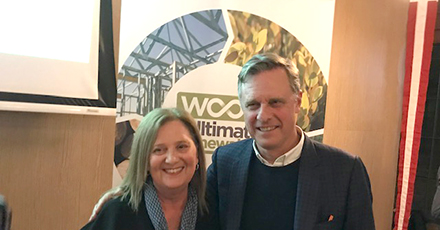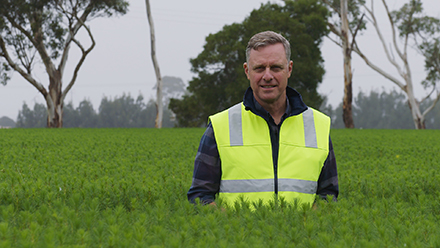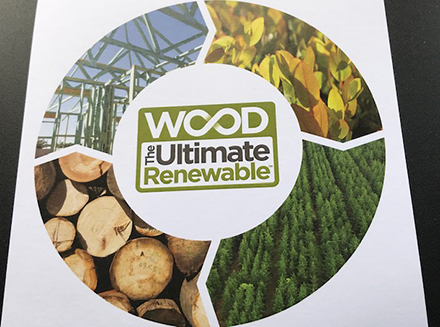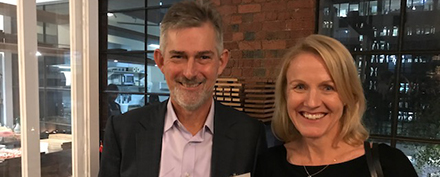
FWPA national marketing manager Eileen Newbury and Peter Maddison with the new logo in background.
A new forestry advertising campaign with the logo, ‘Wood: The Ultimate Renewable’, is set to hit the screens, not just as a re-invigorated branding, but as a strategic reframing and an organising idea for the whole forestry sector. The campaign, launched in Melbourne on Tuesday night, will again feature well-known architect and television presenter Peter Maddison in 15-second and 30-second ads that will start appearing on television and in outdoor locations from next month. Source: Philip Hopkins for Timberbiz

Peter Maddison in the new advertisement for Wood: The Ultimate Renewable.
The ads will feature Mr Maddison, who presents the ‘Grand Designs Australia’ television program, extolling timber as a renewable and sustainable resource. The ads will cover both hardwood and softwood products.
The chairman of Forest & Wood Products Australia, John Simon, said the campaign and logo constituted a refreshing of the ‘Wood Naturally Better’ branding. The idea arose out of a meeting with the former Forestry Minister, Anne Ruston, who had pushed for a way to explain forestry to the average voter, he said.

The chief executive, Ric Sinclair, said FWPA had spent $1.8 million on the campaign, which was the result of collaboration between all sections of forestry. These included Planet Ark,The Commonwealth Department of Agriculture (Forestry), VicForests, the Forest Corporation of NSW and OneFortyOne plantation company.

FWPA chief executive Ric Sinclair and Christine Flanagan, from Calco Trusses and Timber.
Market researcher Pollinate led the way in developing the campaign. The chief executive, Howard Parry-Husbands, told the audience that the ‘Ultimate Renewable’ brand was not simply a thought by a bunch of foresters.
“It was based on a thorough analysis of the existing forestry situation in Australia and then developed from successive rounds of collaboration and co-design, both with industry and stakeholders as well as consumers, across five states,” he said.
“We gather here today as testament to the power of collaboration over conflict and the benefit of evidence-based, long-term strategic planning over short-term, partisan self-interest.”
Mr Parry-Husbands said building a positive message for forestry faced a paradox: people liked agriculture and ‘lamb’, but the slaughter-house was absent from perceptions, whereas forestry had become synonymous with ‘logging’ – the slaughter-house.
This suppressed public support for forestry and stifled investment in the industry when the world was demanding renewable alternatives to concrete, steel and plastics, he said.
FWPA commissioned Pollinate to review all their past research – 36 projects – and to review hundreds of media articles.
“The results were very clear. Forestry was not so much defined by negativity. Media coverage of forestry was defined by negativity. Most people had little knowledge of forestry and the majority of people were actually benignly supportive of forestry,” he said.
“No one was talking about technology or innovation… forestry was justifying its existence on the basis of jobs and growth but was not considered ‘viable’ as it was seen to be destroying the environment.”
Mr Parry-Husbands said virtually no one knew that foresters replanted the trees they harvested. People took wood and paper products for granted even though they were looking for alternatives to plastic.
The upshot was a series of workshops and interviews around Australia to find a new narrative for forestry. “What did we find? Technology and a ‘smart’ industry was an early favourite, demonstrating the public’s desire to discover an industry that used high-tech machinery and LIDAR satellites, and a product that was in growing demand globally,” he said.
“Health and well-being, aligned to the growing field of ‘biophilia’ or natural design and its demonstrable health benefits, was also well received. Interestingly, frames based on values such as humility or certification, did not fare so well. People were very interested in paper and wood replacing plastic but only where the wood and paper was juxtaposed with being sustainable or renewable.”
Mr Parry-Husbands said a clear story emerged. Any frame that used the word ‘renewable’ performed best.
“Renewables instantly lent a sense of cleanliness to forestry and wood,” he said.
However, the timescale jarred; solar and wind came every day, but trees took 20 years to grow.
“They would reconcile this with the reality that trees still grow back just as farmers sow, nurture, reap and sow again. It’s simply the timber between harvesting that is longer,” he said.
Mr Parry-Husbands said the wording that most resonated was ‘Wood: the ultimate renewable’.
“It worked just as well for forestry production as for timber processing and wood and paper products,” he said.
“But perhaps the most important learning from this journey is the ability to transform the forest conflict. Almost everybody across all of the research arrived at the same realisation: that forestry was a renewable industry,” he said.
“The basis of the forest wars – at least in the public’s mind – is ignorance of replanting and a concern that forestry practices are somehow damaging to the environment.”
Mr Parry-Husband said people in the research noted that forestry must show a tangible change on the ground.
“We need the public to experience a perception of change, not just a change in perception,” he said.
“If the industry can expand, if it can innovate, if it can demonstrate the role it plays in transition from unsustainable, polluting materials to a world built on renewable resources then the future is very bright indeed for the ultimate renewable.”
Mr Simon pointed out that appropriately, Wednesday (yesterday), was World Environment Day.





